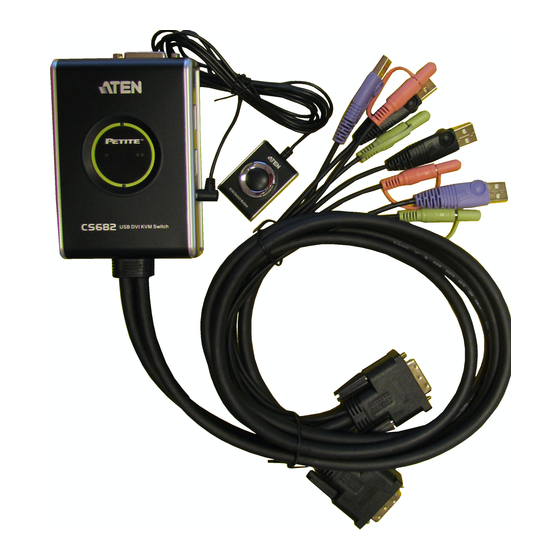Table of Contents
Advertisement
Advertisement
Table of Contents

Summary of Contents for ATEN CS682
- Page 1 USB 2.0 DVI KVM Switch USER MANUAL CS682...
-
Page 2: Emc Information
EMC Information FEDERAL COMMUNICATIONS COMMISSION INTERFERENCE STATEMENT: This equipment has been tested and found to comply with the limits for a Class B digital service, pursuant to Part 15 of the FCC rules. These limits are designed to provide reasonable protection against harmful interference in a residential installation. -
Page 3: Online Registration
CS682 User Manual Online Registration International http://eservice.aten.com Telephone Support International 886-2-8692-6959 86-10-5255-0110 China Japan 81-3-5615-5811 Korea 82-2-467-6789 North America 1-888-999-ATEN ext 4988 United Kingdom 44-8-4481-58923 Technical Support For international online technical support – including troubleshooting, documentation, and software updates: http://eservice.aten.com... -
Page 4: Package Contents
Copyright © 2014 ATEN International Co., Ltd. Manual Date: 2014-10-31 - Manual Part No. PAPE-1337-AT4G ATEN and the ATEN logo are trademarks of ATEN International Co., Ltd. All rights reserved. All other trademarks are the property of their respective owners. - 4 -... - Page 5 Overview The CS682 takes a giant step forward from prior cable KVM models in the Petite series, by offering DVI functionality, USB 2.0 peripheral sharing (via a USB hub attached to the USB mouse port), a rich bass experience for 2.1 surround systems, and a firmware upgrade function that allows you to keep up with latest available versions.
- Page 6 Power on detection – if either of the computers is powered off, the CS682 will automatically switch to the other computer Supports multimedia keyboards Supports wireless keyboards and mice...
-
Page 7: System Requirements
A DVI video port USB Type A port Speaker and microphone ports (optional) Cables The CS682’s innovative design features built-in KVM and audio cables for extra convenience. No further cables are necessary. - 7 -... -
Page 8: Operating Systems
Operating Systems Supported operating systems are shown in the table, below: Version Windows 2000 / XP / Vista / 7 Linux RedHat 6.0 and higher SuSE 8.2 and higher Mandriva (Mandrake) 9.0 and higher UNIX 4.3 and higher FreeBSD 3.51 and higher Solaris 9 and higher Novell Netware... - Page 9 Components CS682 Remote Port Selector - 9 -...
- Page 10 The LED is off to indicate the port is not selected. KVM Cable The connectors on the built-in KVM cables attach to the two computers in your CS682 installation. See the diagram on page 12 for further details. Console Keyboard Your console USB keyboard plugs in Port here.
-
Page 11: Installation
1. Plug your keyboard and mouse into their USB ports, located on the side of the CS682. The ports are color coded and labeled with an appropriate icon. Note: The mouse connector is actually a USB 2.0 port, and can accept any USB compatible peripheral. -
Page 12: Installation Diagram
Installation Diagram USB 2.0 Hub KVM Cable - 12 -... -
Page 13: Operation
Operation The CS682 provides three convenient methods of selecting computers: Manual – click the pushbutton on the Remote Port Selector; Mouse – click the mouse’s scroll wheel; and Hotkey – enter combinations from the keyboard. Manual Port Selection Press the port selection pushbutton on the Remote Port Selector to toggle the KVM and Audio focus between the two computers. -
Page 14: Hotkey Port Selection
Hotkey Port Selection All hotkey operations begin by tapping the Scroll Lock key twice. See the Hotkey Summary Table for full details. Note: If using [Scroll Lock] conflicts with other programs, [Ctrl] can be used instead. Alternate Entering Hotkey Mode Press [Scroll Lock] [Scroll Lock] [x] [Enter]. -
Page 15: Hotkey Summary Table
Hotkey Summary Table Combination Function [Scroll [Enter] Toggles the KVM and Audio focus between the two Lock] ports. If the KVM and Audio focus are on different [Scroll ports, only the KVM focus switches. Lock] + [k] [Enter] Only toggles the KVM focus. [s] [Enter] Only toggles the Audio focus. -
Page 16: Keyboard Emulation
Keyboard Emulation PC Keyboard Mac Keyboard PC Keyboard Sun Keyboard [Shift] Shift [Ctrl] [T] Stop [Ctrl] Ctrl [Ctrl] [F2] Again [Ctrl] [F3] Props [Ctrl] [1] [Ctrl] [F4] Undo [Ctrl] [2] [Ctrl] [F5] Front [Ctrl] [3] [Ctrl] [F6] Copy [Ctrl] [4] [Ctrl] [F7] Open [Alt]... -
Page 17: The Firmware Upgrade Utility
Firmware Upgrade package for the CS682 from our Internet support site ( www.aten.com 2. Disconnect the CS682 from your KVM installation. Press and hold the Remote Port Selector’s pushbutton. While you are still holding the pushbutton, connect the KVM cable’s purple USB connector to a USB port on the computer you have downloaded the Firmware Upgrade package to. -
Page 18: Troubleshooting
2. Press and hold the Remote Port Selector’s pushbutton. While you are still holding the pushbutton, reconnect the KVM cable’s USB connectors to the computer. 3. Power on the CS682. It will now work with the factory default firmware. Follow steps 3 to 9 on page 17 again. Troubleshooting... -
Page 19: Specifications
Specifications Function CS682 Computer Connections Console Connections Port Selection Remote Port Selector, Mouse, Hotkeys Connectors Console 1 x USB Type A Female (Silver) Ports Video 1 x DVI-D Female (White) Mouse 1 x USB Type A Female (Silver) Speakers 1 x Mini Stereo Jack Female (Green) Mic. -
Page 20: Factory Default Hotkey Settings
Factory Default Hotkey Settings Setting Default Port Switching [Scroll Lock] [Scroll Lock] Auto Scan Interval 5 seconds Keyboard Operating Platform PC Compatible Mouse Emulation Mouse Port-Switching Power on Detection Enabled Limited Warranty IN NO EVENT SHALL THE DIRECT VENDOR'S LIABILITY EXCEED THE PRICE PAID FOR THE PRODUCT FROM THE DIRECT, INDIRECT, SPECIAL, INCIDENTAL OR CONSEQUENTIAL DAMAGES RESULTING FROM THE USE OF THE PRODUCT, DISK OR ITS DOCUMENTATION.







